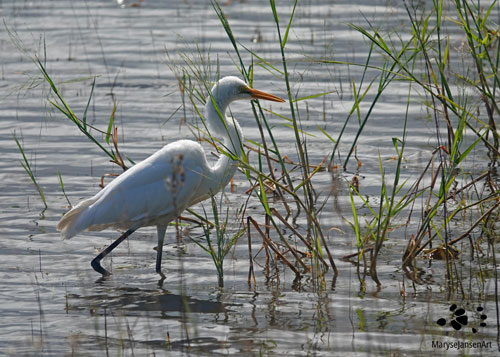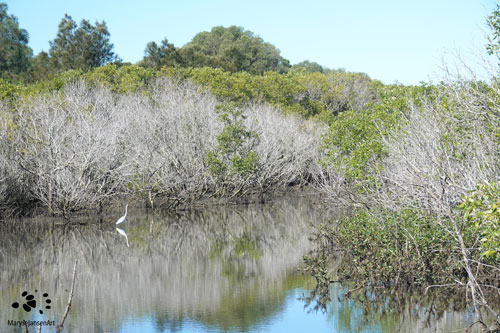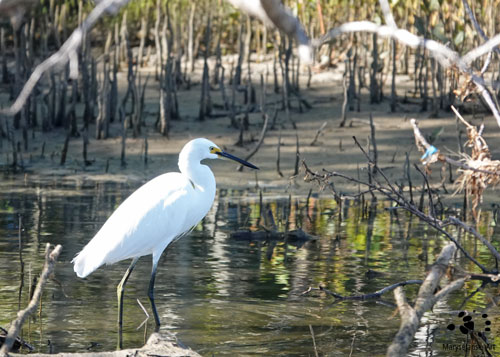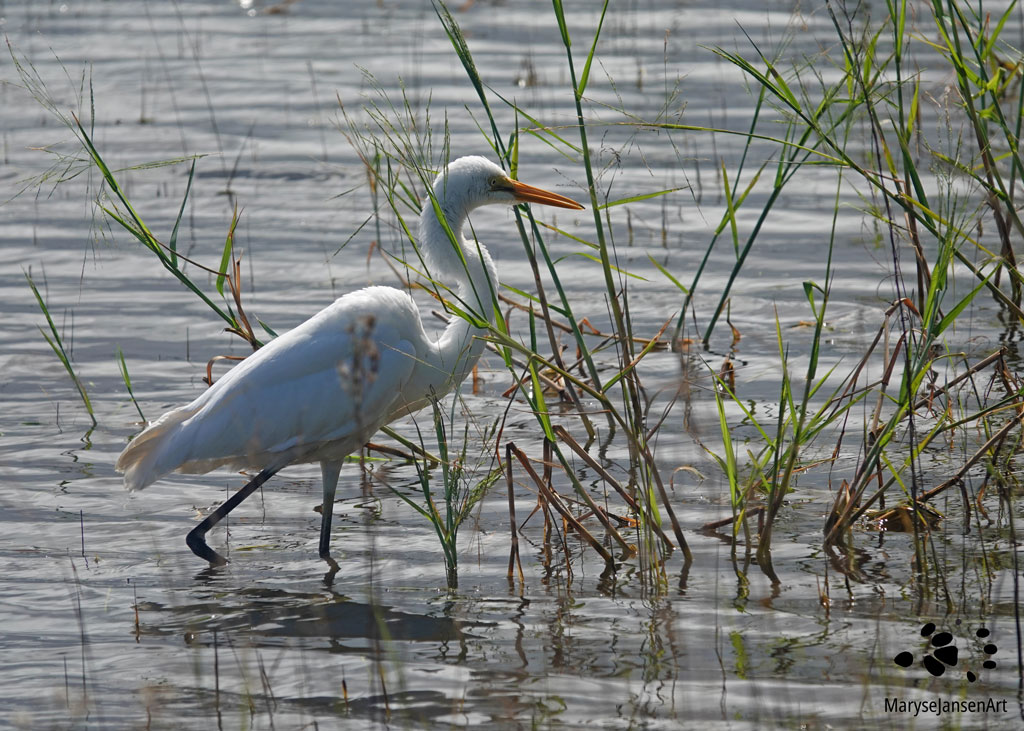Bird Photography with marysejansenart
Eastern Great Egret, Intermediate Egret and Little Egret

Table of Contents
Contrasting the Landscape
During my walks I regularly come across a white egret. There are three species of white egrets that are very similar in appearance: they are all white, tall, slender birds with long necks and long pointy beaks, hunting for aquatic animals in shallow waters. I’m talking about the Eastern Great Egret, the Intermediate Egret and the Little Egret.
Due to their white plumage these egrets often contrast brightly with their environment, whether it’s the green of the vegetation, the blue of the sky or the brown colours of the sand. This makes for great photos, as you can see in the image below. On its own it is a beautiful landscape of a freshwater hole on the beach, framed by mangroves which are reflected in the water. But it’s that bright white bird, also reflected in the water, that gives the image something extra!

The bird in this image is an Eastern Great Egret, while the bird in the featured image is an Intermediate Egret. So, how do we tell them apart?
Looks
First of all, we can distinguish them from each other based on size. The Intermediate Egret, as you would expect from the name, is the middle sized bird out of the three. It grows about 65cm tall. The Little Egret grows up to only 56 cm tall and the Eastern Great Egret with 75-90cm is by far the tallest bird of the three species!
Further, you can see that all three birds have a fully white plumage but there are slight differences in colouring of their bills, eyes, legs and facial skin:
- The Little Egret has a black bill, a yellow iris, a yellow face, and black legs.
- The Intermediate Egret has a yellow bill, a yellow eye, a yellow face and dark legs.
- And the Eastern Great Egret has a yellow bill with a dark tip, a yellow face and dark legs. Another important feature of this egret is the extremely long neck, longer than the length of its body.

Breeding Plumage
The differences become more prominent in breeding season:
- In breeding season the Eastern Great Egret’s bill will turn completely black, the face will turn somewhat greenish and the legs pinkish-red at the top, down to the knees.
- The Intermediate Egret’s bill will turn bright red, the eyes turn red, the face green and the upper half of the legs will also turn red. Interestingly, this bird changes colour again during the laying phase and during the time of hatching to gradually return to its non-breeding plumage.
- In contrast, the Little Egret doesn’t change much at in colouring all!
On top of these interesting changes in colouring all three egrets develop so called nuptial plumes during the breeding season, but they do so in different places on the body which will also help us identify them:
- For the Little Egret you will see these on the back and the breast and 2 distinctive ones on the head.
- The Intermediate Egret has them on its scapulars and breast.
- The Eastern Great Egret has plumes across its lower back.
These plumes are used in courtship when the birds preen, stretch, shake, toss and flap with their bodies fluffed up and all plumes erected. It is absolutely a splendid sight!
All three egret species have both sexes involved in the building of the nest, incubating the eggs and feeding the chicks. They tend to breed in colonies, often with other birds such as Cormorants, Spoonbills, Ibises, and other Herons. A clutch consists of 2-6 eggs, usually 3-4. Incubation takes about 3-4 weeks and the young birds fledge around 40-45 days later.
Hunting Skills

Egrets are hunters. Their prey consists mainly of fish, but they take all sorts of aquatic animals such as amphibians, reptiles, aquatic insects and molluscs. It is fascinating to watch them at work. In the image ‘Don’t Mind Me‘ (above), the Intermediate Egret has assumed a standing and waiting position, completely upright so that it is well camouflaged between the stems of reed. Another technique it uses is walking slowly through shallow waters, ready to stab prey with its sharp beak. This is demonstrated in the featured image.
The Little Egret is a more active hunter. It may shuffle its feet to disturb prey, actively stalk it by wading through the water or even by running after it with raised wings.
The Eastern Great Egret is the most patient hunter of them all. It can wait for a long time, often with its head tilted sideways, looking with one eye. It may also walk very slowly and will stab the prey with its bill.
The egrets usually feed alone, but occasionally may be seen hunting in groups in places where food is abundant.
Distribution and Habitat
The Eastern Great Egret is the most widespread of the three species and can be spotted throughout most of Australia, except for the arid areas. The Intermediate Egret can be found in northern and eastern Australia and the Little Egret can also be found there as well as occasionally in Western Australia. All egrets need shallow waters to hunt in so they can be seen in a great variety of wetlands, coastal as well as inland. I have spotted them at lakes, dams, creeks, rivers, in the mangroves, at the beach and in marshes.
During a fantastic walk at the beach I spotted all three species discussed in this post! There were also many other amazing birds on this walk, with the ocean on one side and the mangroves on the other. I share this walk in my new video in the ‘Come for a walk in the Australian Bush’-series, which you can view below.
If you are interested in purchasing ‘Intermediate Egret on the Hunt’ or would like to see what the image looks like on the various products, please head to my shop. If you’d prefer ‘Don’t Mind Me’, click shop here. For the image of the Little Egret, click shop here, and for ‘Great Eastern Egret in Mangrove Landscape’, click shop here.


